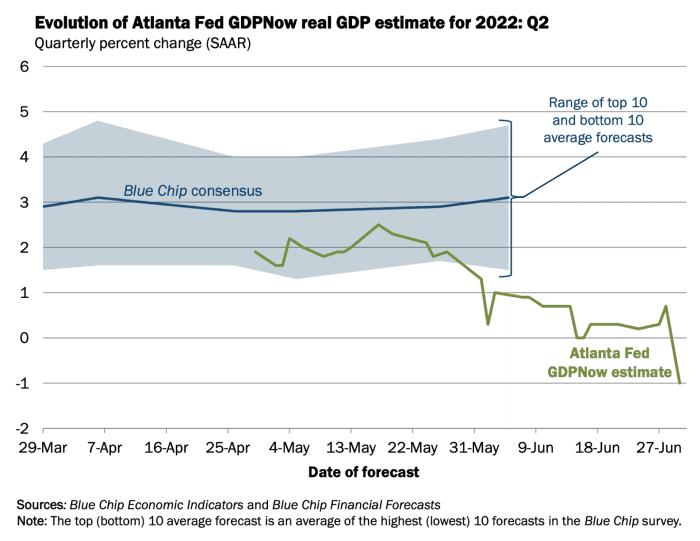This post was originally published on this site
Fears of a sharp slowdown are getting the blame for the stock market’s renewed slide while also driving a retreat in Treasury yields. A look at a regional Fed bank’s closely followed economic-growth indicator may justify investor jitters, said a top Wall Street researcher.
The Federal Reserve Bank of Atlanta’s GDPNow model on Friday forecast a 2.1% second-quarter fall in U.S. gross domestic product following a slide in the Institute for Supply Management’s June manufacturing index and data on construction spending. The Atlanta Fed had lowered its estimate Thursday to -1% from a rise of 0.3% after data on personal consumption and expenditures, tripping alarm bells for recession-wary investors.
If the forecast is on track, it would mark the second consecutive fall in GDP after a 1.6% contraction in the first three months of 2022.
“We are ending Q2 on an economic low note, which goes a long way to explaining why 10-year Treasury yields
TMUBMUSD10Y,
have come in so dramatically from their June 14th highs of 3.48 percent,” wrote Nicholas Colas, co-founder of DataTrek Research, in a Friday note.
“Stocks have taken no comfort from the recent decline in yields because they see the same issue portrayed in the GDPNow data: a U.S. economy that is rapidly cooling,” he said.
The 2-year
TMUBMUSD02Y,
and 10-year Treasury yields fell below 3% on Thursday after hitting a 11-year high earlier this month as the odds of a recession appeared to be growing. Treasury yields move opposite to price.
The S&P 500 on Thursday closed out its worst first half performance in more than 50 years. The large-cap benchmark
SPX,
fell 20.58% year-to-date through Thursday’s close, and was down 21.08% from its record close on January 3, before bouncing 1.1% in Friday’s session. The Dow Jones Industrial Average
DJIA,
fell more than 15% in the first half.

SOURCES: BLUE CHIP ECONOMIC INDICATORS AND BLUE CHIP FINANCIAL FORECASTS
The Atlanta GDPNow is updated in real time as fresh economic data rolls in, using a methodology similar to that employed by the Bureau of Economic Analysis in its official gross domestic product forecast. It’s not an official Atlanta Fed forecast, but it is a widely watched indicator and “important to watch” as “it has a strong track record, and the closer we get to July 28th’s release the more accurate it becomes”, according to Colas.
Colas noted that 28 days ahead of the official BEA release, the model averages an absolute error of 1.2 points. Seven days ahead of the report, the error rate shrinks to 0.8 point.
“The model’s long-run track record is excellent,” he wrote. “Since the Atlanta Fed first started running the model in 2011, its average error has been just -0.3 points. From 2011 to 2019 (excluding the economic volatility around the pandemic), its tracking error averaged zero.”
Though a second consecutive quarter of negative growth of the U.S. economy would meet a generally-used definition of recession, the National Bureau of Economic Research (NBER), the official arbiter of U.S. business cycles, uses different criteria. The NBER’s definition of a recession is that “it is a significant decline in economic activity that is spread across the economy and that lasts more than a few months”.
Read More:The Dow just booked its worst first half since 1962. What history says about the path ahead.
Stocks, meanwhile, the Dow Jones Industrial Average
DJIA,
climbed 255.18 points, or 0.83%, to 31,034 on Friday afternoon. The S&P 500 was up 27 points, or 0.72%, at 3,812. The Nasdaq Composite
COMP,
increased 63.07 points, or 0.58%, to 11,094.
Read More: Guggenheim warns U.S. economy likely entered recession during the second quarter

